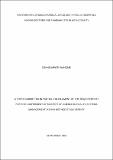Factors influencing rational drug use in public hospitals among doctors and pharmacists in Meru County

View/
Date
2019-09Author
Wahome, Dennis Mwiti
Type
ThesisLanguage
enMetadata
Show full item recordAbstract
Access to essential medicines, vaccines and medical technologies is the anchor pillar in this study. Medical products must be of assured quality, safety, effective, scientifically sound and cost effective. Rational use of medicines requires that a patient receives appropriate medications to their clinical needs, in doses that meet their own individual requirements, for an adequate period of time and at the lowest cost to them. It is concerned with how commodities are selected, procured, used and stored to ensure that the patients receive quality and efficacious products appropriate to their medical needs. There are a number of challenges that have been encountered in the rational use of drugs. These include lack of essential drugs, gaps in training and weak implementation of policy guidelines. The broad objective of this study was to assess the factors that influence rational drug use among doctors and pharmacists in public hospitals in Meru County. Specifically the study sought to determine how staff awareness on policy guidelines, management practices, product selection and inventory management influence rational drug use among doctors and pharmacists. A cross sectional study design was adopted having quantitative approaches. The sample size was 102 doctors and pharmacists who work in the public hospitals in Meru County. Both stratified and simple random samplings were used to sample the staff. A five point Likert scale based questionnaire was used to collect data. Quantitative data was analyzed using SPSS Version 23. Correlations were done between the dependent variable RDU and independent variables Staff awareness, inventory management, production selection and management practices. Significance levels were done at both 5% and 1%. There was a significant relationship between RDU and staff awareness (r=.232*, p=0.019) and inventory management (r=.324**, p=0.001). Coefficient of determination (R) of 0.402 was obtained compared to overall R2 of 0.162 and this explains 40.2% of total variations that explained factors that influence rational drug use among the healthcare workers in Meru County. The ANOVA findings (F (4,97)=4.68, p=0.002) shows that there is correlation between the predictors variables Staff awareness, management practices product selection , Inventory Management, and the dependent variable Rational drug use. This study recommends: i)The hospitals develop training manuals on rational drug use that will be used to create awareness on importance of Rational drug use among doctors and pharmacists to enhance knowledge and build capacity, ii) departmental heads to offer support supervision, quarterly assessment, appraisals and implement RDU in collaboration with doctors and pharmacists, iii) All the hospitals to constitute active Drugs and Therapeutics Committees in all the facilities to ensure that formularies are developed, policies are communicated and SOPs implemented, to enhance uniformity and build capacity, iv) to constitute procurement committee with all stakeholders including the doctors and pharmacists to ensure they are involved in the budgeting, selection and monitoring of Essential drugs.
Publisher
KeMU
Subject
rational drug useCollections
- Thesis [44]
